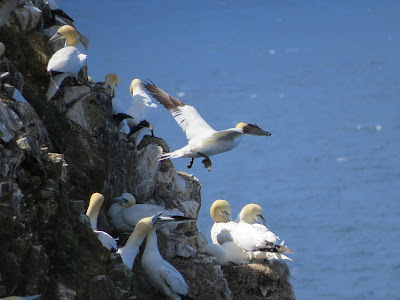This is the day I've been waiting for, ever since booking the holiday way back in February, a chance to explore the highest region in the country and its special wildlife.
There are two ways to get to the summit: the first is to take the train up, the second is to walk. Obviously it would be idiotic to come all this way to take the train. Our group split 50-50 with the old and decrepit in the group opting for the train whilst myself and others walked.
From the Cairngorm car park the mountains seemed a daunting prospect - I'm from East Anglia, where there are no hills, Facing up to the most mountainous region in the UK.
However, as the mountains were not particularly steep, the path was fairly gentle: there weren't too many steps and it wasn't too steep. There were two waterfalls to pass, stretching the legs a bit, but were fairly undemanding. Orchids lined the side of the path, before gently falling away as we went higher. The habitat ascended from heather moorland, to a grassland strewn with boulders. It was a well used path and there was a steady stream of people using the path. The trail was well maintained, marked by gravel, with occasional steps dug into the mountainside.
From a small rocky summit was where we encountered our first birds, with a party of five PTARMIGAN. From there the hilltop plateaued encountering more PTARMIGAN, this time a bird with chicks. These are related to RED GROUSE, except they inhabit a niche habitat, the high mountain tops.
We climbed higher and higher looking for more of our targeted birds, not stopping until we had found them all.
A PEREGRINE FALCON flew overhead, carrying some large prey, but no DOTTEREL. So we had a plan, and that was to spilt up 50 metres apart and to move over the desolate mountain top, until we found something, and we found something indeed.
Two DOTTEREL, changing to three, then to a maximum of four. From the different states of plumage there were two each of male and female. They were very plover like in the way they ran for a lot then would stop dead still then run again.
DOTTEREL are mountain plovers, where the sex roles are reversed. The female is the more bright and colourful, whilst the male looks after the chicks. The birds were very tame and didn't seem to notice us at all, they never moved away because of us.
And just as we were admiring them, a call came of...
SNOW BUNTING! - a black and white male BUNTING flew passed and landed not too far away. While we were looking at it the DOTTEREL actually came closer!
After admiring the DOTTEREL we went back to look for the BUNTING, but instead disturbed a female. Then we saw another bird running on the ground and discovered a fledged juvenile SNOW BUNTING, one of maybe ten nesting pairs in the country. We decided to keep away, to allow the birds some privacy.
DOTTEREL and SNOW BUNTING habitat 3800 feet up
Having seen all the species we wanted, we were allowed to go back down. As we did we saw more PTARMIGAN, they had the habit of exploding from the rocks when you were just about to step on them. We saw maybe twenty in total.
Walking back was fairly simple, everyone contented from the day we had experienced. When we talked about the at the end of the tour, this was most people's favourite day.
In the end, we had walked seven hours, at a distance of around eight miles and a height of around 3800 feet, not bad for non-mountaineers.
































